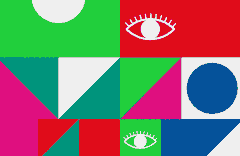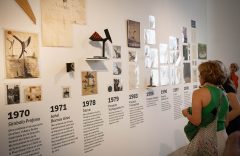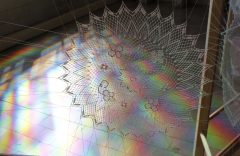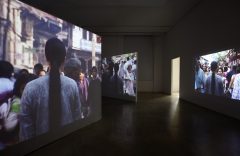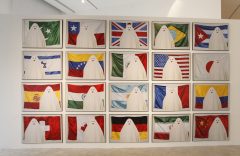
A wide variety of shows and exhibitions with the participation of artists and curators from Germany, Saudi Arabia, Belgium, Bolivia, Brazil, Canada, Chile, Colombia, Korea, Cuba, Denmark, Ecuador, Spain, United States, France, Honduras, Iran , Israel, Italy, Mexico, Peru, Poland, Puerto Rico, United Kingdom, Romania, Sweden, Venezuela and Argentina are part of a program rich in content that invites us to think about art in relation to modern and current times.
The MUNTREF Headquarters at the Immigrants’ Hotel, Km 0 BIENALSUR in the City of Buenos Aires, Argentina, has a series of site-specific exhibitions and installations around the curatorial axes Transits and migrations, Ways of living, Ecological awareness and Politics of art .
Under the curatorial axis Transits and migrations, “KIMSOOJA BUENOS AIRES. Chapter 1: Kimsooja. The encounter with the other”, which is curated by the Artistic Director of BIENALSUR, Diana Wechsler (ARG), works by the conceptual artist Kimsooja (COR) are presented. The recovery of the daily actions of women in Korean society, their objects, uses and customs is part of them, with a strong emphasis on the action of sewing.
Kimsooja’s production includes bottaris, a characteristic object of the female universe in Korea that consists of a bundle made up of a colorful blanket that wraps a brief selection of significant objects for its owner. The bottari is not only a leitmotiv of her career, but also resignifies itself in the encounter with different cultural horizons. The performances and their videos –another form of bottari as an immaterial “wrapping”– include various fabrics, bottaris and different means of transportation.
To Breathe, Archive of Mind, Bottari: 2021, Thread Routes and A Needle Woman are some of the works exhibited.
Kimsooja’s work seeks to establish various links in the different cultures and societies where she lives while traveling through territories with the serene parsimony of the observer in search of an encounter with the other, moving away from the Western performance tradition. Her passing through Buenos Aires is presented in its entirety, in the form of chapters in various spaces, such as the National Museum of Fine Arts and the Korean Cultural Center.
Within the same axis, within the framework of the exhibitions of the MUNTREF Headquarters at the Immigrants’ Hotel, is Between us and the others: TOGETHER APART, curated by Diana Wechsler (ARG), Benedetta Casini (ITA) and Alex Brahim (COL). It features the works of the Collective MO (COL), Francis Alÿs (BEL/ MEX), Daniel Arévalo (COL), Marcos Ávila Forero (FRA), Yosman Botero Gómez (COL), Marcelo Brodsky (ARG), Iván Candeo (VEN) , Antonio Caro (COL), Gabriel Castillo (COL), Sergio “Bayo” Durán (COL), Juan Carvajal Franklin (COL), Raimond Chávez (COL) and Gilda Mantilla (PER), Juan Pablo Echeverri (COL), Alexandra Gelis (VEN) and Jorge Lozano (COL), Oier Gil (ESP), Núria Güell (ESP), Matteo Guidi and Giuliana Racco (CAN), Angie Jácome (COL), Khaled Jarrar (PSE), Glenda León (CUB), Carmen Ludene (VEN), Esperanza Mayobre (VEN), Verena Melgarejo Weinandt (DEU-BOL), Daniela Ortiz (PER), Nukanchik People (ECU), Dan Perjovschi (ROU), PSJM (ESP), Adrián Preciado (VEN), Samir Quintero (COL), Lester Rodríguez (HND), Betsabeé Romero (MEX), María Ruido (ESP), Avelino Sala (ESP), Slavs and Tatars (POL/IRN), Barthelemy Toguo (CMR), and Wilmer Useche (COL).
BIENALSUR seeks to overcome borders while respecting differences, with the conviction that the cultural dimension is key to thinking about possible dialogues between diverse sociopolitical universes. Such is the case of TOGETHER APART, a project that has begun in 2017. It originated in Cúcuta, a city located on the border of Colombia and Venezuela, where cultural and knowledge exchanges between both countries are revealed.
For its part, in the gardens of the MUNTREF, Kiosk, by the artist Peter Johansson (SWE/DNK) curated by Benedetta Casini (ITA), is presented.
“It is a site specific installation inspired by surveillance architecture. Johansson points out the similarity of the popular structures with other current uses and performativities, such as those found in foodtrucks and food kiosks, and triggers reflections on the symbolic value of the booths, the concept of the prefabricated and the standardization of experiences. The artist modifies the original appearance of the sentry boxes, and with it the associated functions, to generate new experiences and expectations” (from the curatorial text).
Panopticon frontier 601 by Nora Ancarola (ARG), curated by Valentín Roma (ESP), takes up the theme of surveillance, with allusions to the research of philosopher Michel Foucault on disciplinary devices from the 16th to the 19th centuries, focusing his attention in three institutions that articulate social indoctrination during modernity: the school, the clinic and the prison. It also refers to the so-called “German booth”, a euphemism used, even today, for the Gestapo bunker installed at the beginning of the Second World War at a strategic point in Portbou. The exploration of border militarization processes and the violence instituted by state power against the migrant population, as well as the penalizing archetypes generated from the media, political and legal spheres, are part of the work.
In relation to the Ecological Awareness curatorial axis is The Water Office, curated by Sofía Bastidas Vivar (ECU), Sofía Casarín (MEX) and Andrea de la Torre Suárez (MEX). It features productions by Adrián Balseca (ECU), Tania Candiani (MEX), Carolina Caycedo (COL), Centro Rural de Arte (ARG), Ramiro Chaves (ARG), Diego Andrés de la Cruz Gaitán (PRI), Jonathas de Andrade (BRA), Peter Fend (USA), Lía García, Canuto Roldán and Arlishan (MEX), Lucía Hinojosa Gaxiola (MEX), David Medina and Entre Ríos (COL/GBR), Laboratorio Amphibio del Plata (ARG), Luisa Lerman (ARG), and Tania Ximena (MEX).
The exhibition is located at the Museum’s SUM and brings together the efforts of thought and artistic representation around the relationship we have with water, recognizing it as an inseparable organism between communities and territories.
Finally, the exhibition Silence still speaks to us includes the creations in ink and charcoal by the artist Muhannad Shono (SAU) and curated by Diana Wechsler (ARG).
*The exhibitions can be visited from Tuesday to Sunday from 11:00 a.m. to 6:00 p.m., with prior reservation through the Museum View MUNTREF mobile application or to the email visitasmuntref@untref.edu.ar. Admission is free.
News
